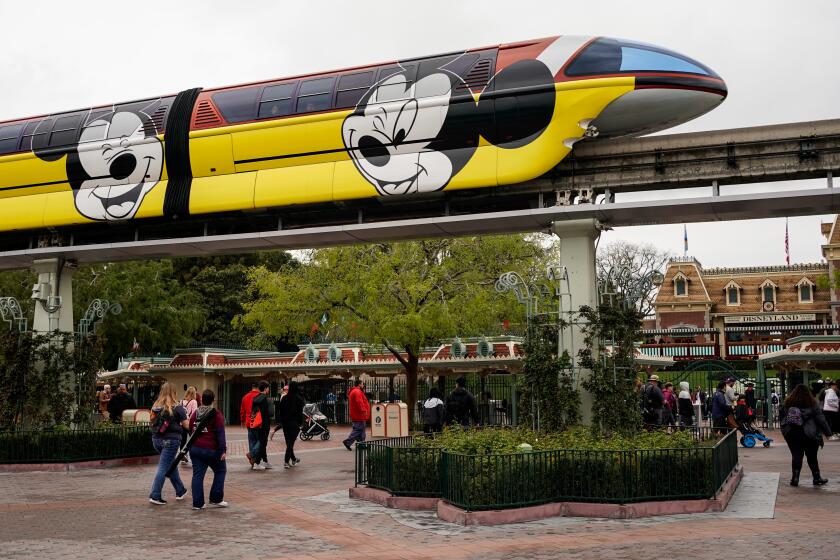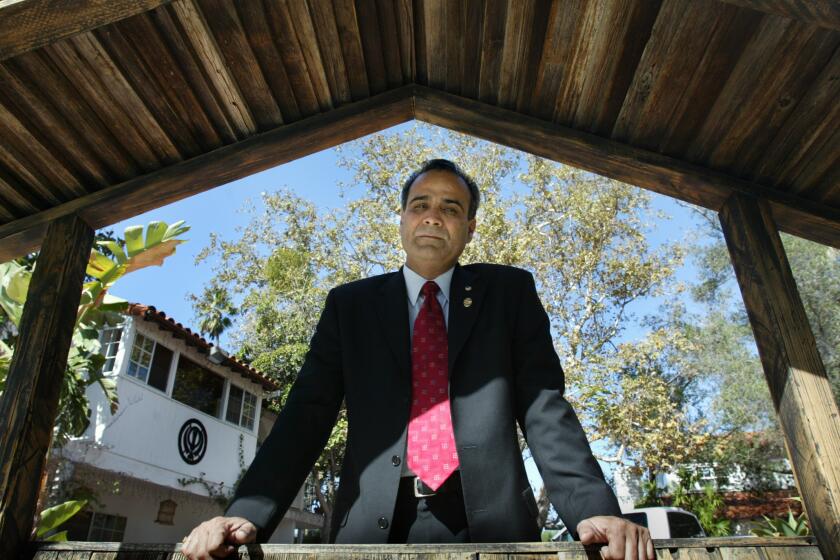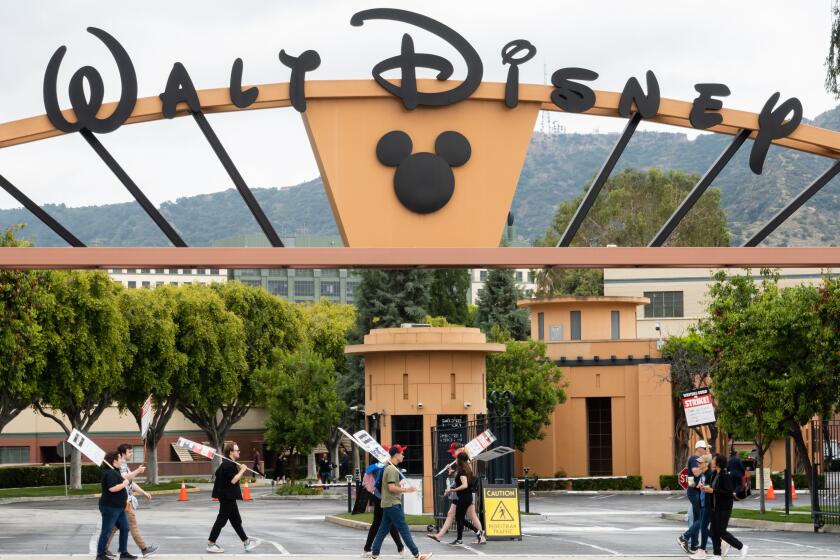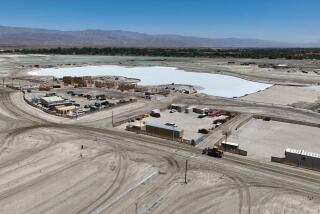Disneylandâs new vision includes up to $2.5-billion investment and a plan to take over city streets
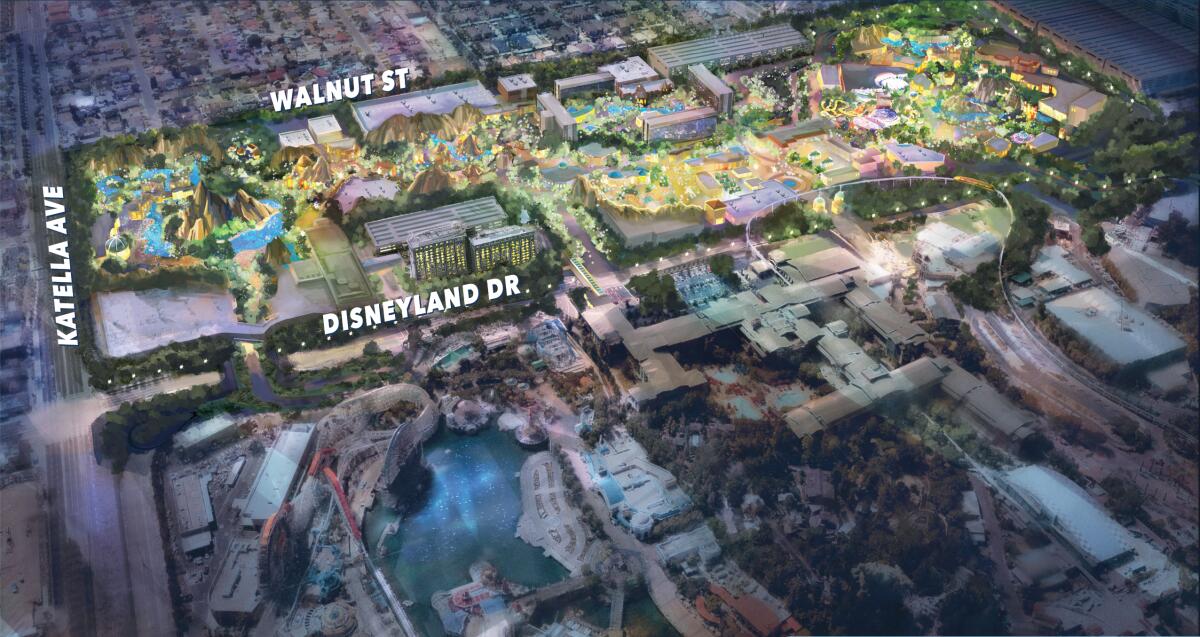
For decades, Disneyland has been hampered from expanding its Anaheim resort due to streets, highways and businesses that encircle the self-proclaimed âHappiest Place on Earth.â
But Disneyland hopes to get around those limits with a plan to spend up to $2.5 billion to reimagine the resort with new attractions, hotels and shops within its current 100-acre footprint â a proposal that would require taking over some surrounding city streets.
The plan already has critics who fear it will create more traffic headaches for neighbors and not provide enough tax revenue for the city.
The plan, presented to the Anaheim City Council Tuesday, would turn the theme park into an even more âimmersiveâ experience by building new areas that would combine theme park attractions, hotels, restaurants and stores in the same spaces, said Disneyâs Global Development Vice President Rachel Alde during the presentation.
Dubbed DisneylandForward, the plan is not specific about what exactly would be built but asks Anaheim to relax zoning rules and give Disney flexibility to redesign the existing resort, which includes Disneyland, Disney California Adventure Park and the Downtown Disney business district.
âThis will allow, for example, theme park attractions alongside or even embedded in hotels and vice versa,â Ted White, planning and building director for the city, said during the Tuesday presentation.
Disneyland is offering $50 tickets for children ages 3-9, but what do you do with 3-year-olds when theyâre too small or timid to go on the rides?
Disneylandâs footprint is not expected to expand. But Disney, a powerful and dominant broker in Anaheim politics, is also asking the city to hand over some adjacent streets to the company. The move would give Disneyland control over Magic Way, Hotel Way and part of Clementine Street near the resort.
In exchange, according to the plans, Disney is proposing to pay $40 million for the roads, what city planners said is fair market price. That payment would be part of a plan by Disney to spend $90 million on Anaheim street improvements near the theme park, including widening Katella Avenue.
Disney is also asking Anaheim to halt its previous plans to extend Clementine Street and Gene Autry Way.
Disney is offering to give the city tens of millions of dollars more in taxes and fees, earmarked for affordable housing, public parks and road improvements.
In all, Disney expects to invest up to $2.5 billion over the next decade on the project and, in addition, pledges to give the city of Anaheim more than $100 million for street improvements, parks and affordable housing.
The multibillion-dollar investment, Disney officials said, could mean thousands of jobs and millions of dollars of tax revenue for the city in what could be one of the most significant expansions of the storied theme park since it was first built in 1954.
Already, hotel stay-tax revenue is Anaheimâs largest source of funding, said Mike Lyster, spokesperson for the city of Anaheim. The city expects to collect $236.3 million from hotel taxes for the last 12 months ending in June, he said.
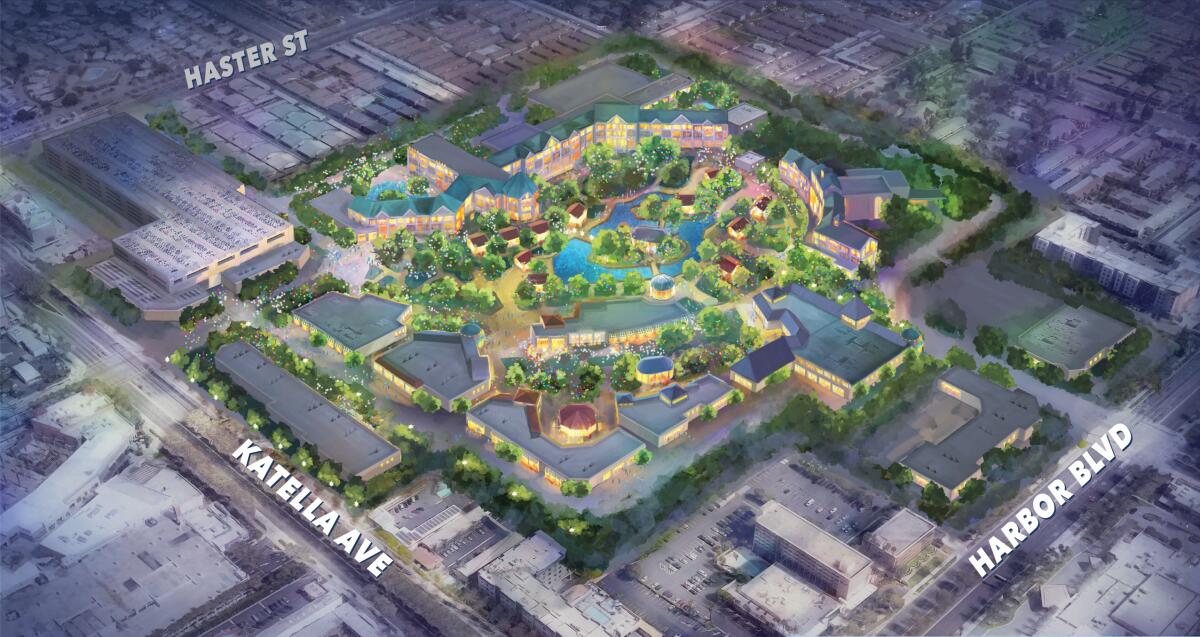
But the expansion of the theme park, as well as the proposal to privatize public roads, is already raising concerns from some Anaheim residents who worry the plan could mean worse traffic in their community, and the resortâs expansion could further increase rents and the cost of living.
âThe âHappiest Place on Earthâ has the saddest communities next door,â said one resident in Spanish, who identified herself as Maricela during Tuesdayâs meeting.
She and other residents at a nearby apartment building received notices, saying they had to leave their homes in December, she said, a decision she believes may have been prompted by the resortâs expansion plan.
âThe expansion hasnât started, and some of us are already being expelled,â she said.
One custodial worker was briefly hospitalized and another was treated at the scene in an incident that happened after the park closed for the night.
Lyster, the city spokesperson, said eviction notices received by apartment building residents are not related to Disneyâs expansion plans.
âOur thoughts and concerns are with anyone dealing with relocation,â he said. âBut it appears the owner is renovating the property within their rights with 60-day notice and relocation assistance as required by state law.â
He said the city has reached out to residents for assistance in apartment searches.
Some residents have also created an online petition in opposition to the privatizing of streets, with worries that Disneyâs privatization of the streets will mean the public will no longer have access to them.
âRoad closures mean that high-value, taxpayer-owned real estate would be privatized for Disneyâs profitable use,â the petition reads. As of Friday, 230 people have signed the petition.
City officials, however, say two of the roads that could be privatized â Hotel Way and Clementine Street â are now used as entryways into a Disney parking lot. Magic Way, Lyster said, would remain open to vehicles heading into the resort.
Among the planned construction, Disney is looking to expand the theme park across Disneyland Drive to Walnut Street, an area designated strictly for hotels under its original plan with the city.
DisneylandForward is asking the city to give the company more flexibility to overhaul areas that were originally designated for hotels to also include park rides, attractions and retail stores.
Disney also looks to build a new 17,000-space parking garage, as well as three pedestrian bridges to cross over Harbor Boulevard, and two additional bridges over Disneyland Drive.
Anaheim is a working-class city whose residents have more pressing concerns than civics, leaving room for unscrupulous officials to operate, Arellano writes.
Under the plan, Disney promises to invest between $1.9 billion to $2.5 billion within the next 10 years. If Disneyâs investment does not reach the $2.5-billion mark, the company vows to pay an additional $5-million payment to the city.
But the proposal, which has been in the works since 2021, follows an Anaheim City Hall corruption scandal. An internal report found a âpotential criminal conspiracyâ regarding COVID-19 relief funds and accused former Mayor Harry Sidhu and the former head of the Anaheim Chamber of Commerce of âinfluence peddling.â
The report came after an FBI affidavit accused Sidhu of misdeeds and being part of a self-described âcabalâ of public figures and influential figures in the city, including a Disney power broker.
The scandal underscored concerns by some residents and city officials that Disney holds undue influence in Anaheim at a cost to its residents.
âInstead of making this franchise richer, I urge you to really invest in our communities who are struggling to afford each and every day despite holding two or three jobs,â resident Yesenia Altamirano said during the Tuesday meeting.
A Disney employee is suing the company for allegedly failing to investigate the sexual misconduct she says she suffered at the hands of an executive, Nolan Gonzales.
During the meeting, Anaheim Mayor Pro Tem Norma Campos Kurtz, said some residents have already approached her with concerns about privatizing city roads and how it could lead to increased traffic on Walnut Street and Ball Road.
City staff said a plan and funding are already in the works to improve traffic flow at the intersection of the two streets.
City Councilmember Natalie Rubalcava said sheâd like Disney to make a greater commitment than the $30 million the company has promised to give the city for affordable housing.
âOne of the things I would love to see Disney commit to in perpetuity is some additional funding for housing, whether itâs first-time home buyer program or a last-mile funding for affordable housing projects,â she said. âI would love to see that in addition.â
But Disney has argued that its multibillion-dollar investment will translate into millions of dollars in revenue for the city.
According to a report cited by Disney, every billion dollars invested by Disneyland could generate $253 million in annual economic output for the city, as well as $15 million in tax revenue. According to the city, an average of 25 million visitors come to Anaheim each year, primarily to visit Disneyland.
More to Read
Sign up for Essential California
The most important California stories and recommendations in your inbox every morning.
You may occasionally receive promotional content from the Los Angeles Times.

